Logic Supply ML100G-30 Fanless Broadwell vPro Industrial NUC Review
by Ganesh T S on April 29, 2015 11:30 AM EST- Posted in
- Systems
- Intel
- Fanless
- NUC
- Industrial PC
- Passive Cooling
- Logic Supply
Performance Metrics - II
In this section, we mainly look at benchmark modes in programs used on a day-to-day basis, i.e, application performance and not synthetic workloads.
x264 Benchmark
First off, we have some video encoding benchmarks courtesy of x264 HD Benchmark v5.0. This is simply a test of CPU performance. As expected, the higher burst clock rate in the ML100G-30 helps it score better than the other systems it is compared against.
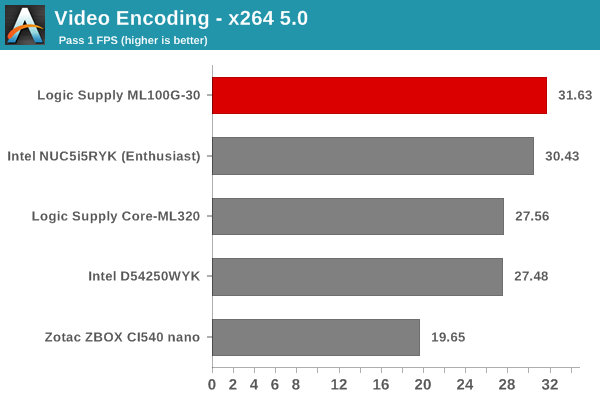
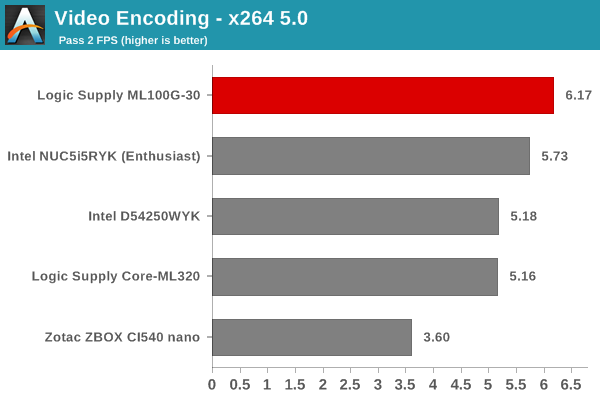
7-Zip
7-Zip is a very effective and efficient compression program, often beating out OpenCL accelerated commercial programs in benchmarks even while using just the CPU power. 7-Zip has a benchmarking program that provides tons of details regarding the underlying CPU's efficiency. In this subsection, we are interested in the compression and decompression MIPS ratings when utilizing all the available threads.
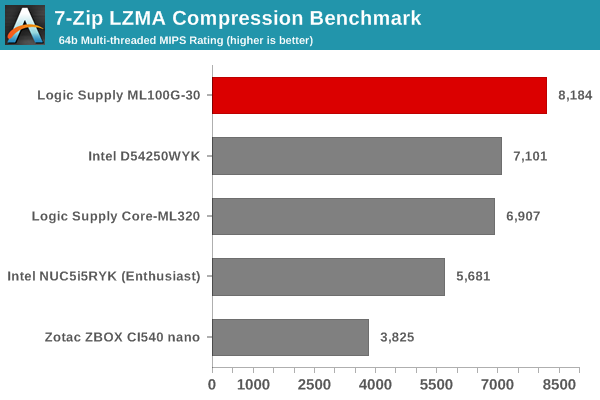
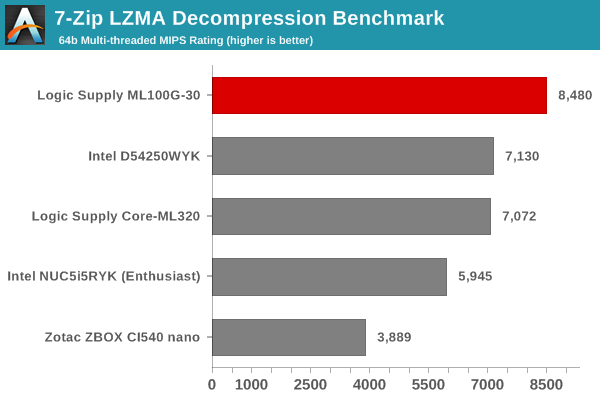
The above results track what we observed in the x264 benchmark, and the reason behind it is also the same.
TrueCrypt
As businesses (and even home consumers) become more security conscious, the importance of encryption can't be overstated. CPUs supporting the AES-NI instruction for accelerating the encryption and decryption processes have, till now, been the higher end SKUs. Since the Core i5-5300U with vPro capabilities is aimed at the business / enterprise market, it does have AES-NI support. TrueCrypt, a popular open-source disk encryption program can take advantage of the AES-NI capabilities. The TrueCrypt internal benchmark provides some interesting cryptography-related numbers to ponder. In the graph below, we can get an idea of how fast a TrueCrypt volume would behave in the Logic Supply ML100G-30 and how it would compare with other select PCs. This is a purely CPU feature / clock speed based test.
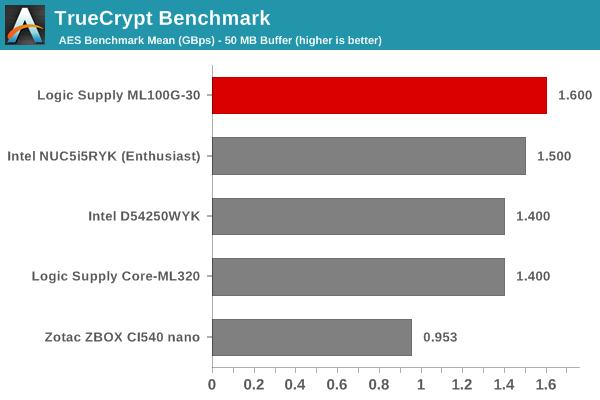
Agisoft Photoscan
Agisoft PhotoScan is a commercial program that converts 2D images into 3D point maps, meshes and textures. The program designers sent us a command line version in order to evaluate the efficiency of various systems that go under our review scanner. The command line version has two benchmark modes, one using the CPU and the other using both the CPU and GPU (via OpenCL). The benchmark takes around 50 photographs and does four stages of computation:
- Stage 1: Align Photographs
- Stage 2: Build Point Cloud (capable of OpenCL acceleration)
- Stage 3: Build Mesh
- Stage 4: Build Textures
We record the time taken for each stage. Since various elements of the software are single threaded, others multithreaded, and some use GPUs, it is interesting to record the effects of CPU generations, speeds, number of cores, DRAM parameters and the GPU using this software.
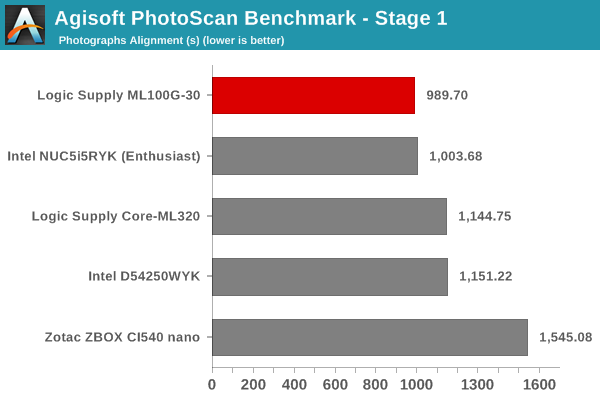


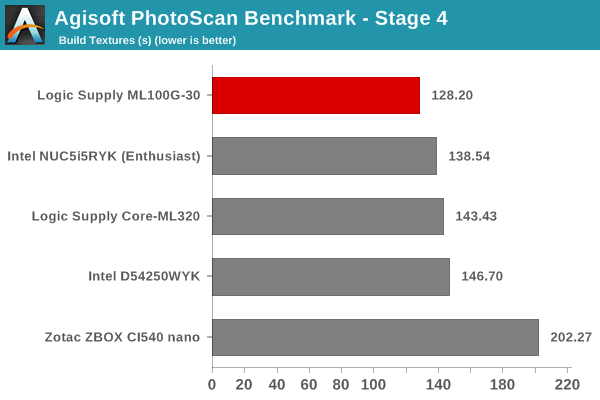
The Logic Supply ML100G-30 performs admirably in the CPU-bound stages. However, when it comes to memory bandwidth-sensitive stages, the unit comes in the middle of the pack.
Dolphin Emulator
Wrapping up our application benchmark numbers is the Dolphin Emulator benchmark mode results. This is again a test of the CPU capabilities and the memory bandwidth available (more of the former).

The results are as expected, with very little to separate the ML100G-30 from the benchmark leader (the enthusiast configuration of the NUC5i5RYK Broadwell NUC).










34 Comments
View All Comments
Pissedoffyouth - Wednesday, April 29, 2015 - link
I have a build based on an Minibox M350 - designed for passive heatsinks or CPU's with fan and <65w TDP.With an A10-7800 it completely smokes these little boxes at a similar size, and for less money.
I'd love to see a NUC with an AMD APU and some decent cooling design
damianrobertjones - Wednesday, April 29, 2015 - link
I have an i7 quad machine that smokes your M350 machine. It's bigger than the Minibox but, then again, your minibox is bigger than the above Nuc.nathanddrews - Wednesday, April 29, 2015 - link
Oh yeah? Well epeen, epeen, epeen!TheinsanegamerN - Wednesday, April 29, 2015 - link
And my desktop smashes both of yours put together. Do I win?Pissedoffyouth - Wednesday, April 29, 2015 - link
Smokes it? What i7? I bet its GPU is worseSamus - Wednesday, April 29, 2015 - link
Broadwell's i7-5557U GPU is pretty damn close to a 192-core GCN GPU but nowhere near a 384+ core GCN GPU such as that in the A10. But it's also 1/4th the TDP, so half the GPU performance and 20% more CPU performance is all well unless you actually plan to game (at low res) on the thing because lets be honest here, both GPU's are unacceptable for HD gaming.It's also worth pointing out the Intel GPU is substantially more advanced regarding features and modern codec support.
blue_urban_sky - Thursday, April 30, 2015 - link
I presumed he was pointing out that if you are using a bigger chassis then it is easy to get a faster system. Your system is 192 x 210 x 62 (2.5l) this is 142 x 62 x 107 (0.95l)Haravikk - Thursday, April 30, 2015 - link
I have an i7-4790T in an Akasa Euler case; I believe it's around the size of the M350, similar price too (at least here in the UK) but a fully aluminium case designed as a heat-sink. The 4790T is 45W, but runs extremely well in the case; running a 1080p encode in Handbrake it can hold 750% CPU use (where all 8 threads is 800%) at a speed of 3ghz, even though it's normal operating speed is 2.7ghz.The only issue with this setup is that mSATA drives are out, as too much heat builds up in the case; I had to swap for a regular 2.5" SSD, and I did put a tiny 40mm Noctua fan in just to help clear the heat build up under heavy load (during normal use it switches off completely).
I'm not aware of any Broadwell compatible thin mini-ITX boards yet, but I imagine doing the same again with Broadwell could achieve even better results.
It does make me wonder why so many of these boxes have such anaemic CPU options, as it's clearly possible to put fairly powerful CPUs in. In fact, my (mostly) passive system replaced a 2008 dual quad-core Mac Pro, and outperforms it in almost every metric in such a tiny system. No ECC of course, but otherwise it's a pretty big (or small) change.
Pissedoffyouth - Thursday, April 30, 2015 - link
That does look like a pretty decent casenatenu - Sunday, May 10, 2015 - link
One of the reasons industrial PCs have lower powered CPUs is not only for thermal reasons but in order to have an industrial control panel be UL 508 approved any PC inside of it needs to be powered by a class 2 DC power supply. That is a power supply that cannot supply more than 100 watts.